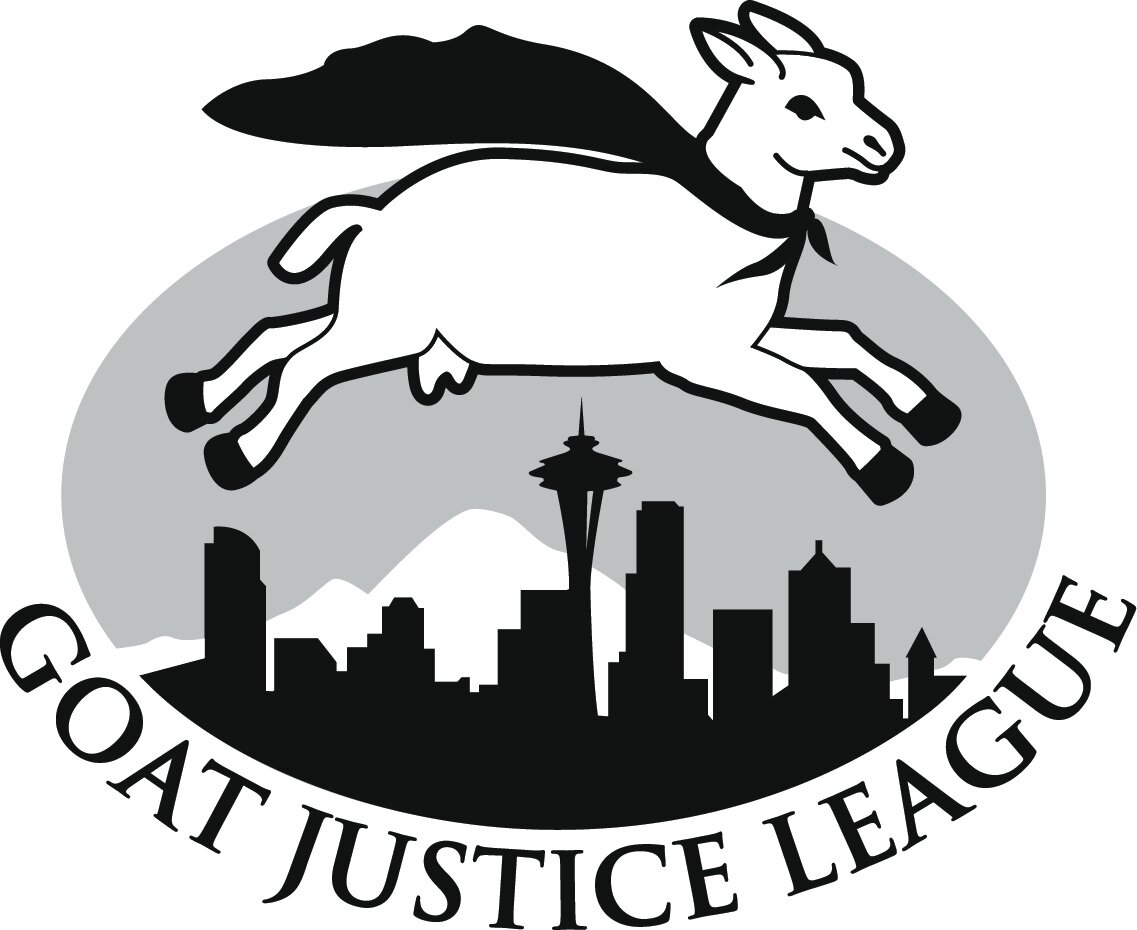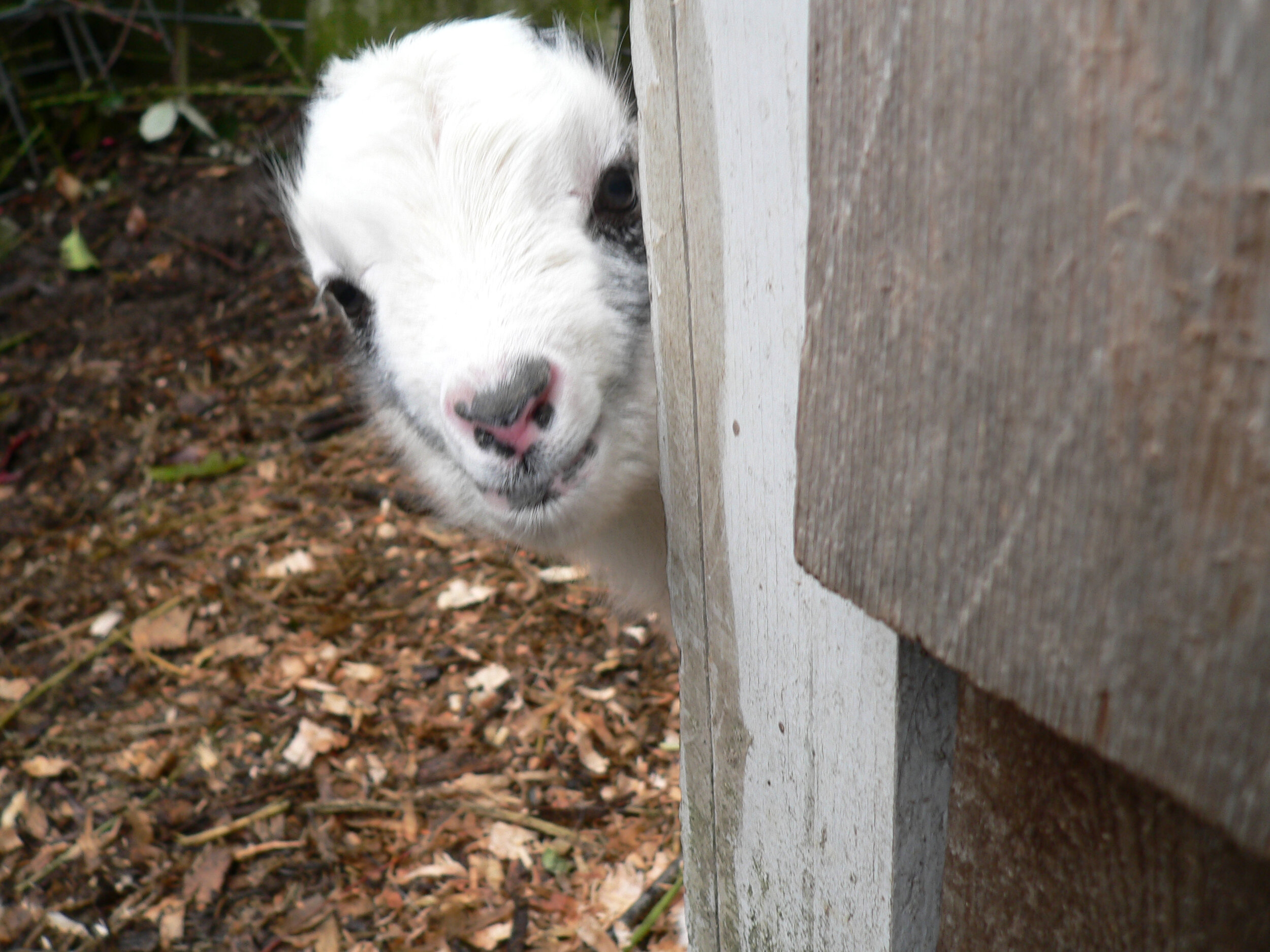Q. What type of goat is right for the city?
Even though goats are now legal in Seattle, it is important to get ones that won’t be too loud. One loud goat could make a bad name for the entire caprine species. I have heard from goat enthusiasts far and wide is that la manchas and oberhaslis are the quietest of all goat breeds. In fact, oberhaslis are probably THE quietest, followed by la manchas. For city living, you’ll want mini-versions of these breeds
This is from back in 2007, a young Joel Salatin takes a sip from his mother, Snowflake. Snowflake was an amazing dairy goat, giving more than a gallon a day during the peak of her lactation.
What is a Mini-Goat?
Mini-goats can grow to about 100 pounds. While larger than Nigerian Dwarves from which they are crossed, they are generally (but not always) better milkers. This mother and daughter are mini-la manchas, half nigerian and half la mancha. Mini-la manchas are a good choice for the city because of their calm and quiet nature and their ability to produce lots of rich milk.
Mini-goat is a term much misunderstood by the American Public. Mini-goats are relatively new. They are created by crossing a Nigerian Dwarf Goat (very small goats) with some other type of standard breed. A mini-dairy goat is a Nigerian dwarf that has been crossed with one of the six standard dairy breeds — La Mancha, Oberhasli, French Alpine, Sanaan, Toggenberg, or Nubian. Thus, there are mini-La Manchas, Mini-Oberhaslies, etc. Mini-goats have the benefit of providing large quantities of milk and not needing a lot of space.
It is often assumed that the terms “pygmy goat” and “mini-goat” are interchangeable. Pygmy goats (more accurately, African Pygmies) are small goats that were developed for meat, so they are a bad choice for anyone who wants to milk a little goat.
A note on Nigerian Dwarves: Nigerians can be excellent milk goats. However, because they are so cute, many people have begun to breed them as pets, so certain lines have lost some of their good dairy qualities. If you get a Nigerian, make sure that the people who bred her are serious about their herd’s milk production.
The Fence
There is an old expression, “It is easier to build a fence to hold water than to build a fence to hold goats.” This is of course, an exaggeration. However, goats are brilliant escape artists so you must build your goat fence with great care. This is ESPECIALLY true if you live in the city. Cities are dangerous places for goats — there are cars and dogs that could easily kill a goat. In addition, there is trouble for a goat to get into such as expensive luxury cars to jump on, prize rose bushes to defoliate, etc. Thus, if you want to keep goats in the city, you need a good fence.
I recommend stock panels. These come about 52 inches tall and 16 feet long and once cut in half, they are easy to handle, do the job, and have a cool, modern look to them. Each panel costs about $40 and they are easy to install.
The Shed
Goats can take extreme cold, but if they get wet, they can easily catch pneumonia and this is quite serious in goats. In building your goat shed, make sure it is tall enough to stand up in. Otherwise, when it’s time to muck it out or when you go in to sweep or check on goats, you will bump your head and curse the day goats entered your life.
This is the shed my husband built. It’s super cool in that it has a roof top deck made accessible by stairs of a chicken coop, grain storage cupboard, and hay storage box. Goats love being up on the roof.
This goat shed has plywood floors that I sweep in the morning and evening. Inside, there are sleeping platforms that also serve as hay boxes so I can store an additional two bales of hay. With my old goat shed, I relied on a double bedding system (described below). I like my new system better in that it seems cleaner and I get compost that is PURE goat poop, without any wood shavings to dampen its strength.
This goat shed was designed by Joshua McNichols, now a reporter at KUOW.
Food
Orchard Grass: This is not straw (stems of what grains grow on) and it’s not alfalfa. It’s dried grass that’s been baled. Get second cutting as it has more leaf than stem. Feed this free choice.
Alfalfa Pellets: Alfalfa is a fabulous food for goats, but when given regular dried alfalfa, goats carefully eat off all the leaves and you have stems galore remaining. Alfalfa pellets are a pelletized form of alfalfa, leaves, and stems together. Your goats won’t pick off just the leaves, so you won’t have waste. Some goats can get fat on alfalfa pellets, but I’ve not had that trouble. I feed them free choice.
Blackberry Bramble: Here in the Pacific Northwest, blackberry is absolutely everywhere and almost everyone is happy to have you come by with clippers and take it away. My collection kit includes welding gloves, a sturdy plastic storage container, and good quality garden clippers. Blackberry leaves are high in protein and calcium. Even better, they are free and fresh! Just make sure you don’t feed any to your goats that have been sprayed with herbicides or pesticides.





